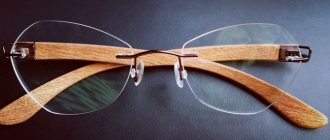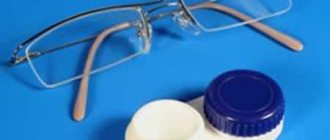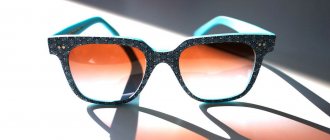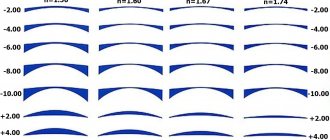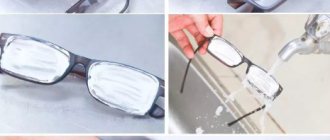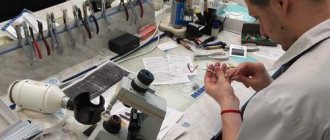What is a frame and why is it needed?
A correctly selected frame ensures the most comfortable position of the lenses in front of the eyes and fixes them in this position. The most optimal position is when the central line of the light opening coincides with the center of the pupil. It is this position of the light opening that ensures wearing comfort. The back surface of the lenses should be 12 millimeters from the top of the cornea. Find out more about the details of glasses for astigmatism in the article.
It is this part of the glasses that provides the light opening. This is the hole in the frame in which the lens is located. The size of the light opening is directly determined by the design of the frame. For example, frameless glasses will have a larger light opening.
Rimless glasses
Often the fit of the frame creates an elevated position of the lenses relative to the middle of the pupil.
RODENSTOCK RUS,
distributor of Rodenstock products
The company offers the widest range of spectacle lenses for children. Let's start with the simplest to the most complex recipes from the Manufactur division. The simplest include Perfalit 1.50 - spherical single-vision lenses, manufactured in the refraction range from –20.00 to +20.00 diopters with a cylinder up to 5.00 diopters, which is included in the price of the lenses (Fig. 1, b). The lenses are also suitable for children's and teenagers' glasses due to their diameters, the minimum of which is 46 mm.
For all other lenses in the catalog, the use is not limited to “adult” glasses thanks to the functions of reducing and/or optimizing the diameter for the selected children's frame. All lenses can be manufactured to the required prismatic power and pre-centration for cases of teenage frames of regular size and small values of interpupillary distance (PD).
The Manufactur catalog offers lenses for special patients with myopia or very high hyperopia, as well as lenses for other medical purposes. Such lenses currently account for 72% of Rodenstock specialty lens sales. Among them, the most frequently ordered for children's vision correction is Perfastar 1.50 - organic single-vision lenses with an implicit lenticular with the best properties possible in optics for high positive refraction (from +8.00 to +22.00 diopters) thanks to high-order surfaces with particularly wide optical zone. The minimum diameter is 50 mm. A cylinder up to 4.00 diopters and a prism up to 5.00 diopters are included in the price of the lens. For children with hypermetropia, Perfastar 1.50 lenses can improve visual perception, therefore they are recommended by doctors to maintain the correct pace of development of a child, even at a young age. These lenses provide eye safety, including protection from ultraviolet radiation with a wavelength of up to 400 nm, as, in fact, all prescription lenses.
Perfalit Starlenti 1.50 are organic lenses with a pronounced lenticular for the correction of high degree hyperopia (from +6.25 to +26.00 diopters) with a diameter of 65 mm with a dome-shaped effective optical zone (Fig. 1, a).
Rice. 1. Solutions for the correction of high degree hyperopia (+20.00 diopters): lenses Perfalit Starlenti 1.50 (a) and Perfalit 1.50 (b) / dn – diameter of the optically effective zone
The differences between Perfalit Starlenti and Perfastar lie in the size of the optical zones and fields of view, image quality, the presence of ring scotomas, and the aesthetics of the glasses, with a clear advantage of the latter of the lenses being compared.
A special “children's solution” in the portfolio of special lenses is Excelit AS bifocal lenses for the treatment of accommodative strabismus in children (Fig. 2). For successful treatment, these lenses must be centered in such a way that, with the glasses properly seated on the face and the head in a normal, habitual position, nearby objects are visible through the near zone, that is, centered higher than conventional bifocal lenses. Ideally, the centers of the pupils lie just above the midline, and the upper line of the segment is located at or just below the midline. In this case, the tension of accommodative convergence is completely compensated by the prismatic action in the center of the near zone, which should coincide with the middle of the pupils. The lenses are lightweight due to their organic material with a refractive index of 1.5; they also protect the eyes from ultraviolet radiation, and the wide segment for near (40 mm) on the outer surface of the C-shaped lens (curved top) is temporally displaced! The refraction range is from –8.00 to +6.00 diopters, the minimum diameter is 40 or 44 mm, that is, the lenses are suitable even for the smallest patients!
Rice. 2. Models of glasses with Excelit AS lenses
The entire range of accommodative lenses is available for schoolchildren with the Mono Plus 2 option, especially for young glasses wearers with astigmatism, thanks to the use of EyeModel technology – unique (only at Rodenstock) and free of charge for lenses manufactured according to astigmatic prescriptions, for better relief and relief transition from the direct direction of gaze to near.
Lenses for children are available in all types of materials, in particular organic materials and Trivex, which guarantee lightness, safety and special eye protection against UV radiation with a wavelength of up to 410 nm.
PRO 410 material is also used, which provides an optimal solution for blocking light that poses a potential hazard to the body and eyes, and transmitting light rays that have a positive effect on non-visual functions. The lenses guarantee better transmission of both image and color and are especially recommended for children's glasses and in the postoperative periods, when treating the consequences of eye injuries.
To filter short-wave blue light, an absorber is added to the lens material - an organic ultraviolet absorber. After its introduction into the material, the lens may acquire a yellowish color, not a very aesthetic appearance, and its color rendering function is disrupted. To neutralize this yellowish color, Rodenstock introduces a color neutralizer into the material. This, in turn, leads to a loss of light transmission, which is why the company developed Solitaire Protect Pro 2 coating specifically for the PRO 410 material, which provides greater light transmission to the lenses than similar lenses from other manufacturers.
Frame elements
Any frame consists of such elements as:
- Frame (an element that secures the lenses on the face);
- Temples or temples (paired elements that secure glasses to the head).
The lenses are connected by an element such as a bridge or bridge of the nose. The frame is connected to the temples using a hinge joint. The greatest comfort is created by the so-called flex or spring-loaded connections.
Standard glasses frame
High-quality hinges ensure comfort and long service life of glasses.
If the temples are made of metal, they are equipped with tips made of silicone or other hypoallergenic material for convenience and to prevent allergic reactions. If the frame is made of metal, its design often involves special nose pads made of rubber or silicone. They provide a better fit for the glasses on the bridge of the nose.
Nose pads on glasses
HOYA RUS LENSES,
distributor of Hoya Vision Care products
Hoya Vision Care's product range includes special spherical design lenses of small diameters (stock range) Hilux Kids, made from both standard material polymer 1.50 and super-strong, virtually unbreakable material PNX 1.53. All of them are recommended for ordering with the Hi-Vision Aqua base anti-reflective coating. The refraction range is from 0.00 to +6.00 diopters, maximum Cyl is up to 2.00 diopters. In addition, you can order prescription lenses of larger diameter for a child, primary school student, teenager or student with any anti-reflective coatings, including special BlueControl coating for protection against blue light, of various designs - spherical or aspherical. Also, for vision correction in children, Hoya Vision Care recommends single-vision lenses Sync III of a special design with a functional additive, which can be prescribed according to the indications of ophthalmologists for adolescents over the age of 13 years. Prescription lenses are available in materials with all possible refractive index values - from 1.50 to 1.67 and 1.74 over a wide range of refractive index and cylinder values.
As noted earlier, for children's lenses there are a number of stock items of small diameters, which are made only from polymer 1.50 and PNX 1.53 materials. Also, for older children in stock positions, you can safely choose lenses of larger diameter, made from materials from polymer 1.50 to Eynoa 1.67, both spherical and aspherical designs. Among prescription lenses, the choice is even wider - it all depends on the preferences and financial capabilities of buyers, as well as on the recommendations of optometrists (ophthalmologists). If desired, you can choose any material, design and coating, including a photochromic option. All Hoya Vision Care polymer lenses protect children's eyes 100% from harmful UV radiation (except for lenses made from polymer 1.50, which only blocks this radiation at wavelengths up to 340 nm). In any case, the manufacturer strongly recommends, if possible, choosing the safest and most durable lens material for children’s glasses, PNX 1.53, which provides 100% UV protection and also, which is very important for children’s glasses, has a very low specific gravity . This means that glasses with lenses made of this material will be very light, which plays a huge role (sometimes decisive) when choosing the best option, since they will not put pressure on children’s small noses and delicate ears.
For comfortable wearing of glasses and maximum protection of children's eyes, Hoya Vision Care offers a range of polymer lens materials with 100% UV protection. Special BlueControl coatings have also been developed that cut out harmful blue light emitted by all digital devices. To ensure that children’s walks in the fresh air are completely safe, and that glasses protect children’s eyes from reflected UV rays, the manufacturer recommends using spectacle lenses with a UV Control protective coating and not ignoring the possibility of ordering photochromic lenses from the Sensity family. In any case, for children's glasses it is necessary to use lenses with at least a basic Hi-Vision Aqua anti-reflective coating to protect the eyes from unnecessary glare and reflections. And higher-class anti-reflective coatings (Super Hi-Vision, Hi-Vision LongLife) will also help extend the life of glasses, as they protect lenses from scratches and provide easy care, containing water-, dirt- and dust-repellent layers.
Frame designs
According to the type of design, all frames are divided into:
- Bezel (also known as full-rim). The light opening of the frame frame in such glasses is completely limited by the rim of the frame. These are not only completely plastic or metal, but also combined frames. This type of frame can also be made from natural materials, such as leather or wood. But such options happen quite rarely;
- Semi-rimless. The lenses are secured with a half-rim, most often at the top. Less common is the lower type of lens mounting using a semi-rimless frame. This type of design is typical for glasses with metal frames;
- Rimless. The lenses in this case do not have a frame rim at all. They are connected using a thin bridge. They are connected to the temples using screw fastenings. To do this, small holes are made in the lenses through which screws can be inserted from the inside. From the outside they are secured with decorative fasteners.
Semi-rimless glasses frame
After selecting the basic design of the frame, you can decide on its shape and materials.
BASIC REQUIREMENTS FOR LENSES FOR CHILDREN'S GLASSES
Lenses for children's glasses must meet the highest criteria for safety from injury, protection from ultraviolet radiation and other potentially dangerous components of the solar radiation range, and have high resistance to scratches and dirt.
Injury safety
Eye injuries are considered one of the leading causes of vision impairment in children, therefore special requirements are imposed on the impact resistance of lenses for children's corrective glasses. The impact resistance of lenses is largely determined by the properties of their material. The table*** shows data on the properties of materials for spectacle lenses, and it follows from them that lenses made of polycarbonate and Trivex have the greatest resistance to impact loads. In the USA, children are required to be prescribed spectacle lenses made from these materials, as they meet the most stringent requirements of the American ANSI and FDA standards for resistance to impact loads. If the child's father and mother refuse to purchase such lenses, the optician must obtain the parent's signature on a "Notice of Liability" document to avoid prosecution in the event of eye injury while wearing glasses with less impact-resistant lenses. In European countries, the use of spectacle lenses made from materials with high impact resistance is not regulated by law, but is becoming mandatory when making glasses for children.
UV protection
The effect of ultraviolet radiation in the A and B ranges (UVA and UVB) on the eyes is among the main causes of visual impairment. There is significant scientific evidence linking the duration of ultraviolet exposure to eye diseases such as cataracts, macular degeneration, pterygium, etc.
Many diseases caused by the influence of solar radiation occur in people at a fairly mature age, but it is in the first decade of life, when the greatest amount of sunlight can penetrate through a child’s lens, that a person can receive the maximum dose of ultraviolet radiation.
As a result, up to 80% of the cumulative effects due to exposure occur before a person reaches 18 years of age.
Immediately after birth, the baby's lens is the most permeable - it allows up to 95% of incoming ultraviolet radiation to pass through. With age, the lens begins to acquire a yellow tint and becomes less transparent: by the age of 25, less than 25% of incident ultraviolet rays reach the retina. Children's eyes are exposed to dangerous ultraviolet radiation due to the child's prolonged exposure to the open air, a more transparent lens, and insufficient use of eye protection - sunglasses and hats.
Many eyeglass lens manufacturers offer lenses made from materials that completely cut off ultraviolet radiation. Many optical shops can clearly demonstrate these protective properties of spectacle lenses using special devices and devices.
Protection against radiation in the blue range of visible light
Blue light is part of natural solar radiation and determines the body's correct biorhythms, it improves cognitive abilities and affects concentration and productivity. However, due to the widespread use by humans of electronic gadgets, the brightness of the images on the screens of which is due to high radiation in the blue range of the spectrum, we feel the excessive influence of blue light at any time of the day at work and at home.
Children are at particular risk because they lack the natural protective pigment in the lens of the eye, have larger pupils, and shorter arms mean they hold digital devices closer to their eyes and use them for up to nine hours a day at school and at home.
Today, excess blue light radiation has been linked to eye hazards such as computer vision syndrome, damage to macular cells, and disruption of the body's sleep-wake cycles. To reduce the entry of blue light into the eyes, a variety of filters and optical coatings are available today, which, together with the lens material, which has a transmission limit at a wavelength of 420 nm, help protect the eyes from the harmful effects of its influence.
High-quality optical coatings
Application of high-quality multifunctional coatings improves the optical and performance properties of lenses. The composition of a multifunctional coating necessarily includes the following layers (also known as coatings):
- Anti-reflective lenses , which reduce the amount of light reflected from the surface of the lenses and increase their light transmission, and also reduce the influence of interfering glare, which makes vision more comfortable. In a child, negative sensations from interfering reflections are aggravated when working in rooms illuminated by fluorescent lamps, the light of which has a certain blinking frequency. Applying anti-reflective coatings to the surface of lenses helps reduce sensitivity to unwanted reflections and make glasses more aesthetically pleasing. Experts in the field of vision correction recommend these coatings for children starting from preschool age.
- Reinforcers , necessary for children who do not always handle their glasses with care. Hardening coatings increase the resistance of plastic lenses to scratches and increase their useful life. Currently, most of the world's leading manufacturers produce lenses with multifunctional coatings, bringing the abrasive resistance of plastic lenses closer to mineral glass.
- Antistatic , preventing the accumulation of static electricity charges on the surface of the lenses, which contributes to less settling of dust and other contaminants.
- The final ones are hydro- and oleophobic , which reduce the adhesion of water and grease-like contaminants, respectively, to the surface of the lenses, facilitating their care and helping to maintain high light transmittance of the lenses.
Frame sizes
To correctly determine the size of a new frame, the easiest way is to use the glasses you already have. On their temples you can find 3 numbers that determine the size of the glasses:
- Bridge size;
- Light opening size;
- Temple size.
All dimensions are determined in millimeters; the values of these numbers are often separated by a slash or a square. If it is not possible to read these numbers, or if you are choosing glasses for the first time, you need to measure the width of your face. This will be the width of the frame. Then you should try on the glasses. If it's comfortable, the frame is most likely the right size.
Components of glasses
When choosing frames, you should not be guided only by size. First of all, the frame should fit well and look aesthetically pleasing.
Selection of frames taking into account individual characteristics
Glasses should fit perfectly into the overall style of appearance. The frame should be harmoniously combined primarily with the shape of the face. An incorrectly selected frame distorts the proportions of the face, emphasizing imperfections. Conversely, a properly selected frame will balance them out. When choosing the material and shape of the frame, it is important to take into account the color type of appearance and eye shade. You can find out how to choose glasses for vision by following the link.
Some eye shades
Another important feature when choosing frames is the most often preferred style of clothing and lifestyle.
Determination of face type
Determining your face type is quite easy on your own. To do this, long hair must first be picked up using a bandage. After this, in front of the mirror, trace the outline of the face in a circle, from the roots of the hair to the extreme point of the chin. The most convenient way to do this is with a water-soluble marker or lipstick. The resulting contour will allow you to accurately determine the shape of your face.
When it comes to choosing rimless glasses, what matters most is not the shape of the face, but the width of the eye area.
There are 5 types of faces:
- Oval. Almost the ideal face type, since almost any frame shape will suit it. It is best if the frame is massive, with a low bridge of the nose, which will distract attention from the elongated nose;
- Rectangular. The facial contour has parallel lines from the temples to the chin and a pronounced lower jaw. It is worth giving preference to oval or rounded frames, which make facial features less heavy. You should not use angular, massive frames that can weigh down your face;
- Trapezoidal. This face is shaped like a pear because it widens at the bottom. A good option would be cat-eye, butterfly-shaped frames or with wide temples. This will visually distract attention from the heavy lower jaw;
- Triangular. It is distinguished by a wide forehead, pronounced cheekbones and a narrow chin. A good option would be frames with an oval or round light opening. Rimless designs are also recommended;
- Round. The face has soft, rounded lines with wide cheekbones often combined with a wide neck. It is worth giving preference to rectangular frames, as well as glasses with high temples.
It is especially difficult to choose frames for people with Asian face types. But many companies produce special lines of frames for this face shape.
Determination of color type
When choosing the color of the frame, it is important to take into account the color type of appearance. They are conventionally divided into four, according to the number of seasons. This:
- Spring type. It is characterized by an abundance of warm tones: peach, pink, golden. Thin skin of a golden-peach hue, often with a delicate blush. Hair is light brown, honey red. Eyes blue, brown, gray or gray-blue. The ideal option would be a thin metal frame in golden or copper shades;
- Summer type. It is always light, almost transparent skin of a soft pink, milky or olive hue. Hair is golden brown, light brown, wheatish in color. Plastic and combined frames of lilac, gray, violet or indigo are well suited;
- Autumn type. Peachy, golden-pink skin perfectly sets off copper-red or brown hair. Frames in green, beige, brown or golden-honey shades work well. Metal frames in copper or gold shades are well suited;
- Winter type. Milky white, almost porcelain skin and dark hair are well set off by frames of black, brown and other rich colors. Silver metal frames look good.
Facial color type
It is important to take into account the color of the eyes, since it should also be combined with the color of the frame.
Preferred clothing style
Like other accessories, glasses should be combined with your preferred clothing style. It is worth highlighting the 3 most common styles:
- Business. The rigor and restraint of style is supported by rimless frames, as well as those made of metal alloys such as titanium or stainless steel;
- Casual. The emphasis on comfort and convenience will be provided by plastic frames, sports-style glasses and rimless models;
- Extravagant. The best option would be retro-style plastic frames, as well as unusually shaped glasses. A good solution would be multi-colored frames made of cellulose acetate.
Clothing style Casual
If you need to alternate between several styles, it is advisable to purchase several pairs of glasses with different frames.
Frame materials
The material of the frame is also important, since the comfort of wearing glasses, their practicality and durability depend on it. The more active a person’s lifestyle, the stronger the frame should be. The most common are metal and plastic frames. There are also combined options that have a stylish look.
Plastics
The most popular materials for making frames are:
- Cellulose acetate (it is pleasant to the touch, practical and has high plasticity);
- Kevlar (a very durable material from which impact-resistant frames are made);
- Nylon (light weight and high strength);
- Optyl (epoxy resin-based material, lighter than cellulose acetate).
Cellulose acetate frame
Carbon fiber or fiberglass can also be used to make frames.
Metals and alloys
Metal frames are highly durable. Most often, corrosion-resistant alloys are used for this purpose. The most commonly used:
- Copper-nickel alloy;
- Stainless steel;
- Aluminum;
- Titanium;
- Beryllium;
- Bronze;
- Gold alloys;
- Cupronickel;
- Monel.
Glasses with metal frames
The most durable, light and beautiful frames are made from titanium alloys.
Frames with gold plating look beautiful.
Natural materials
Natural materials can also be used to make the most original frames:
- Animal horn;
- Tree;
- Genuine Leather.
These frames are environmentally friendly and have an unusual look. But they require quite complex care.
Wood frame
Durable lenses for children
The main requirement for lenses for children's glasses is, of course, safety! This means that the lenses must be, first of all, impact resistant. The most durable lenses today are spectacle lenses made from Trivex and polycarbonate.
Spectacle lenses made of polycarbonate.
Abroad, the material of first choice for children's spectacle lenses is polycarbonate, since it is characterized by the highest resistance to impact loads, and glasses with polycarbonate lenses are the most injury-proof. In the USA, if, due to the higher cost of polycarbonate lenses, parents refuse to purchase them, they are required to sign a special document “Duty to warn”, which states that they have received all the information about the properties of the lenses and warned about the benefits of polycarbonate lenses.
In Russia, in most cases, children's glasses are still made with mineral glass lenses, which, of course, is unsafe. Glasses made on the basis of heavy mineral lenses can cause tics in a child, disrupt the normal growth of the nasal septum, lead to irritation and infection of the skin, slipping of glasses and, as a result, inadequate correction, as well as a feeling of discomfort and a decrease in the child’s motivation to wear glasses . Children lead a more active lifestyle, engage in active sports and games using objects that are potentially dangerous to the eyes, so glasses based on mineral lenses can themselves be a source of additional danger. The consequences of eye injuries from fragments of broken spectacle lenses can be very sad, which is why many ophthalmologists insist on prohibiting the use of mineral lenses in the manufacture of children's glasses, considering them an additional risk factor. The use of plastic lenses, in particular polycarbonate, helps preserve the health of the child, in particular his organ of vision.
In addition to high impact resistance, which is almost 10 times higher in polycarbonate than in the most common polymer CR-39, polycarbonate has a number of properties that make it very attractive for making glasses. Thus, polycarbonate has a higher refractive index (1.59). The higher refractive index of polycarbonate means that eyeglass lenses made from it will be thinner, and therefore lighter, than those made from conventional plastic.
However, polycarbonate is a soft material. It scratches easily. Therefore, to increase the service life of polycarbonate spectacle lenses, hardening coatings are applied to them. Coatings are applied to both sides. Typically, hardening coatings are part of multilayer multifunctional coatings that give spectacle lenses not only hardening, but also anti-reflective, water- and dirt-repellent, and antistatic properties.
It's no secret that UV radiation is harmful to the eyes, especially for children. Polymer materials have a high degree of ultraviolet radiation filtration. Polycarbonate absorbs 98-100% of radiation in the medium and long-wave energy components of the UV range, which are the most dangerous for the structures of the eye. Any of the specialized optical plastics has a much higher degree of ultraviolet filtration compared to optical glass!
So, the main advantages of polycarbonate spectacle lenses are:
- High impact resistance - 12 times higher than conventional plastic lenses and 60 times higher than glass lenses;
- Polycarbonate lenses are very light (50% lighter than plastic) due to the low specific gravity of the material, so glasses with them are much more comfortable;
- Glasses with polycarbonate lenses look neater and more aesthetically pleasing, because they allow you to make lenses much thinner due to a higher refractive index (35% thinner than plastic ones);
- Polycarbonate lenses are safe - under impact load they will not shatter into fragments, but will be deformed, so they are actively used for making children's glasses and for sports;
- Polycarbonate itself absorbs ultraviolet rays in the range of up to 380 nm, so polycarbonate lenses do not even need to be subjected to additional treatment for UV protection.
Trivex spectacle lenses
The main advantages of spectacle lenses made from Trivex material:
- Image clarity. Trivex provides image clarity across the entire diameter of the lens, and the patient does not feel any manifestations of chromatic aberration, even when wearing high power lenses.
- Light weight. With a specific gravity of 1.11 g/cm3, Trivex is one of the lightest optical materials. This means that with the optimal selection of the shape and size of the frame, choosing lenses from Trivex, it is possible to produce light and comfortable glasses.
- Impact resistance. Trivex lenses withstand the most stringent impact tests, making them suitable - along with polycarbonate lenses - for use in potentially hazardous situations such as sports and industrial environments.
- Durability. Trivex lenses are highly compatible with multifunctional or hardening coatings, and the high strength characteristics of the material make them resistant to mechanical deformation when worn.
- Chemical resistance. Trivex is more resistant to harsh chemicals than many other organic optical materials. This makes it easier to process and care for Trivex lenses, allowing them to be wiped with cleaning agents containing ethyl alcohol without causing microcracks.
Frame shapes
Not only the design, but also the shape of the frame is important. The right choice will make your face more expressive. The same rule applies to sunglasses. Even when it comes to glasses for vision correction, the frames should be comfortable and beautiful. The shape of the frame should be harmoniously combined with the type of face. Find out about the types of men's glasses here.
For men
When choosing frames for men's glasses, you should also primarily focus on your face shape. It can be:
- Drop glasses (good for square face shapes);
- Aviators (a popular shape for sunglasses);
- Glasses with rectangular frames (good for oval faces);
- Panto (glasses that provide full vision due to the design of the rim);
- Wayfires (glasses with trapezoidal frames);
- Lennons (round glasses made popular by John Lennon).
John Lennon, who made this type of glasses famous. In the fashion world, this frame is named after the musician.
Glasses with clubmaster frames are also quite comfortable. They have rounded light openings and reinforced plastic “arcs”. More about women's eyeglass frames here.
For women
Choosing the shape of women's frames allows you to turn glasses for vision correction into a stylish accessory. The most common types of frames are:
- "Cat's Eye";
- Butterfly;
- Wayfarers;
- "Dragonfly";
- Panto;
- "Droplets";
- "Clubmaster."
Cat eye frame
The same rules should be taken into account when choosing sunglasses.
With the right frame selection, you can bring your face shape closer to an ideal oval if desired.
